|
Introduction

Epidermis

Cortex

Leaves

Spines

Poisons

Wood

Root Succulence

Apical Meristems

Cephalia

Flowers

Travel

Published papers
| |
Modifications to Shoot Apical
Meristems
The evolution of stem-succulence in cacti altered selection pressures acting on
shoot apical meristems (SAMs). Think of a piece of vine about three meters long (and a
few millimeters wide) compared to a section of shoot of a giant columnar cactus
also 3 m long (and maybe 400 mm wide): which plant contains more epidermis cells (just
consider the stem epidermis, not the leaf epidermis, which is produced by leaf
meristems); which has more cortex cells; which has more pith cells? You can
immediately appreciate that, compared to the apex of a vine, the cactus shoot
apical meristem will have to produce vastly more cells to construct any
particular length of stem. But actually it is worse than that. The succulent
stem is much heavier than the narrow stems of most plants, and consequently
there has been a great reduction in the amount of branching: if every branch and
twig of an ordinary non-succulent tree (such as an oak or a maple for example) were as
wide and heavy as a branch of a columnar cactus, the oak or maple would either just
fall apart or would crush its trunk. Instead, cacti branch much less than most
other plants (palms excepted) and many have just a single stem, and thus just a
single shoot apical meristem. That means that whereas the primary body (all the
slender twigs and root tips) of a non-succulent tree is constructed from the
activity of thousands of shoot apical meristems, the primary body of cacti is
produced by just a few, or even by just a single shoot apex.
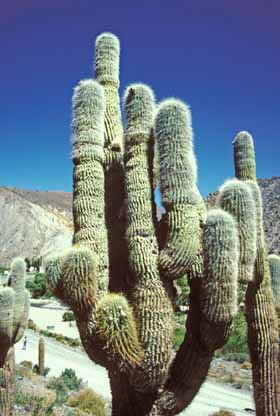 |
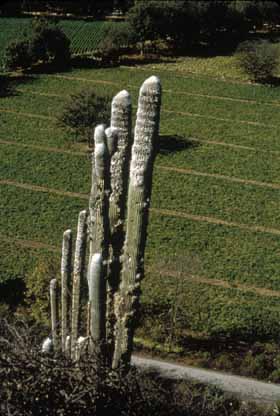 |
|
|
Branches of Trichocereus pasacana
are so thick and heavy that if this plant branched extensively, the trunk
would be crushed from the weight. All the billions of cells in this plant
are being produced by just a few shoot apical meristems. |
Branches of Cephalocereus senilis
are also so heavy that the plant cannot branch extensively. The gray areas
at the tops of these branches are lateral cephalia; click on the Cephalia
link on the left side of this page for more details. |
Click on any photo
for a larger image. |
Having a greatly reduced number of shoot apical meristems increases risk in
several ways. Most obvious of course is that damage to one twig out of thousands
is negligible whereas damage to one shoot tip out of just a dozen (or just one)
is serious. But all the spine clusters of cacti are axillary buds and each has a
dormant shoot apical meristem, so damaged meristems can be replaced in cacti as
easily as in any other plant. The real threat is to the DNA in the meristem
cells. An important concept is not the total number of body cells that must be
produced by a meristem but rather the total number of body cells produced by
each meristem cell, as discussed by Dr. E. J. Klekowski. Each twig in a non-succulent tree is
short and slender and contains just a few epidermis, cortex and pith cells
("just a few" being less than a few hundred or thousand), and the
work of producing that small number of cells is divided among several hundred
meristem cells. If the whole tree is considered, all those thousands of twigs
together must contain close to a million meristem cells. But the evolutionary
conversion of narrow stems into giant ones in cacti put added work on the
meristem cells: if there were no other change, then each shoot apical meristem
cell of a cactus would have to produce vastly more cells than any SAM cell of a
maple or other plant. And every time a meristem cell replicates its DNA, there
is the chance that a copy-error mutation will be introduced into the meristem
cell's nucleus.
As the number of cell divisions per cell increases, the chance of damaging the
DNA increases. But there was compensatory evolution in the SAMs of cacti: they
too increased in size to the point that now some cacti have the largest shoot
apical meristems known – 2.0 mm in diameter – large enough to be seen easily
with the naked eye. Rather than containing a few hundred meristematic cells as
in other plants, cactus apical meristems contain thousands of cells (or maybe
tens of thousands – the number has not been calculated yet). This large size
brings the number of cell divisions per cell down greatly.
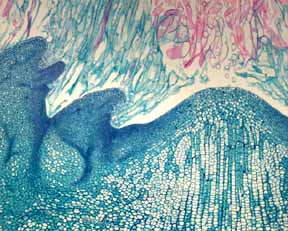 |
Light micrograph of the shoot apical
meristem of Oroya peruviana. This meristem is huge, but not the
largest ever found. To the left are two leaf primordia with vascular
bundles beginning to form in their bases, and the leftmost leaf primordium
has a large spine primordium. All the pink and blue material above the
meristem are hairs. Click on
photo for a larger image. |
But the evolutionary increase in SAM size had other consequences besides
reducing the number of cell divisions per cell: it altered phyllotaxy. Leaf primordia are
initiated at the base of shoot apical meristems, so as increased succulence
created selective pressure for larger meristems, that resulted in meristems with
such large basal circumferences that they have room to produce vastly more leaf
primordia than other plants. The size of leaf primordia has not increased as
much as has the shoot apical meristem itself, so the increasingly larger basal
circumference is occupied by larger numbers of leaf primordia, not by a constant
number of larger primordia. Consequently, cacti with giant apical meristems have
high phyllotaxy, often very high phyllotaxy, involving numbers high in the
Fibonacci series. It is ironic that as cacti were losing the capacity to make
large, ordinary leaves, they were gaining the capacity to make huge numbers of
leaf primordia.
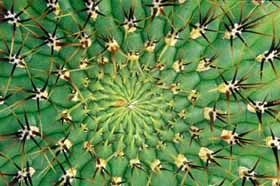 |
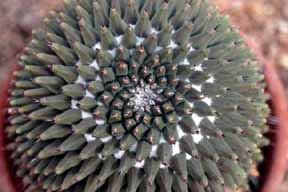 |
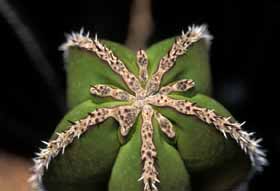 |
|
Shoot apex of Matucana aureiflora,
showing the largest vegetative leaves in subfamily Cactoideae, and showing
high phyllotaxy. Click on any
photo for a larger image. |
Mammillaria magnimamma with high
phyllotaxy. Each conical structure on the surface is a tubercle -- the
base of a microscopic leaf located at the tubercle tip. Although the
leaves are invisible, their patterning is obvious. |
As a shoot grows, its apical meristem
increases in diameter up to a certain point; after that, the size
stabilizes and the phyllotaxy is set. But as size increases, more leaf
primordia can fit around the meristem's base, so phyllotaxy changes. This
Pachycereus marginatus has initiated five new ribs. |
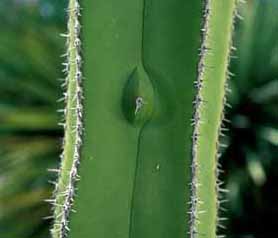 |
Left: Apparently, a shoot apical
meristem can change its mind. It thought it would be a good idea to start
another rib, but...... Pachycereus
marginatus. |
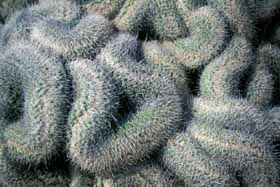 |
|
Right: A crested Mammillaria.
Very often, shoot apices in cacti become extremely long in one direction although they
remain narrow in the perpendicular direction (and height is not affected). The entire ridge is a single shoot apical meristem. |
Molecular genetic studies are revealing the complex interactions between many
different genes in the functioning of shoot apical meristems. As cactus meristems evolved to be dramatically larger than those of other
plants, especially compared to those of Arabidopsis thaliana, the
interaction of those gene products had to be altered as well if the meristems
were to continue to function properly. For example, genes such as
SHOOT-MERISTEMLESS, WUSCHEL and CLAVATA must control much larger
volumes of SAM tissue in cacti than they do in A. thaliana, and genes
such as PERIANTHIA might establish much more extensive fields of
inhibition around leaf primordia. The giant shoot apical meristems of cacti
should make it possible to more accurately map gene expression patterns relative
to SAM zonation and leaf primordium sites.
Mauseth, J. D. 2004. Giant shoot
apical meristems in cacti have ordinary leaf primordia but altered phyllotaxy
and shoot diameter. Annals of Botany 94: 145-153.
Mauseth, J. D.
1978. An investigation of the morphogenetic mechanisms which control the
development of zonation in seedling shoot apical meristems. American Journal of
Botany 65: 158 – 167.
Mauseth, J. D.
1978. An investigation of the phylogenetic and ontogenetic variability of shoot
apical meristems in the Cactaceae. American Journal of Botany 65: 326 – 333.
Mauseth, J. D.
1979. Cytokinin‑elicited formation of the pith‑rib meristem and other effects of
growth regulators on the morphogenesis of Echinocereus (Cactaceae)
seedling shoot apical meristems. American Journal of Botany 66: 446 – 451.
Mauseth, J. D.,
and K. J. Niklas. 1979. Constancy of relative volumes of zones in shoot apical
meristems in Cactaceae: implications concerning meristem size, shape, and
metabolism. American Journal of Botany 66: 933 – 939.
Niklas, K. J.,
and J. D. Mauseth. 1980. Simulations of cell dimensions in shoot apical
meristems: implications concerning zonate apices. American Journal of Botany 67:
715 – 732.
Niklas, K. J.,
and J. D. Mauseth. 1981. Relationships among shoot apical meristem ontogenic
features in Trichocereus pachanoi and Melocactus matanzanus
(Cactaceae). American Journal of Botany 68: 100 – 105.
[end Apical Meristems page]
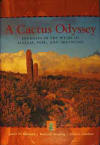
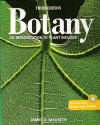
|
